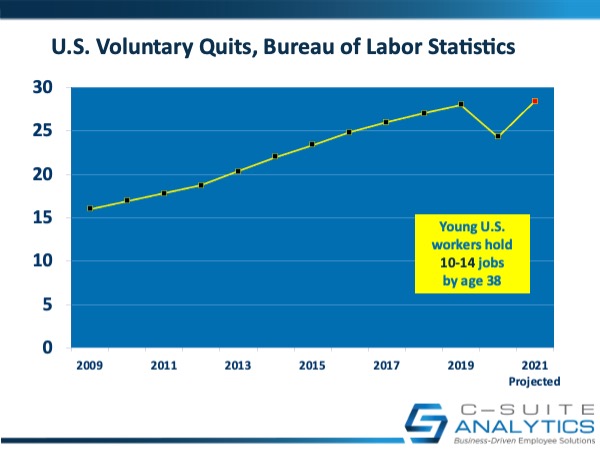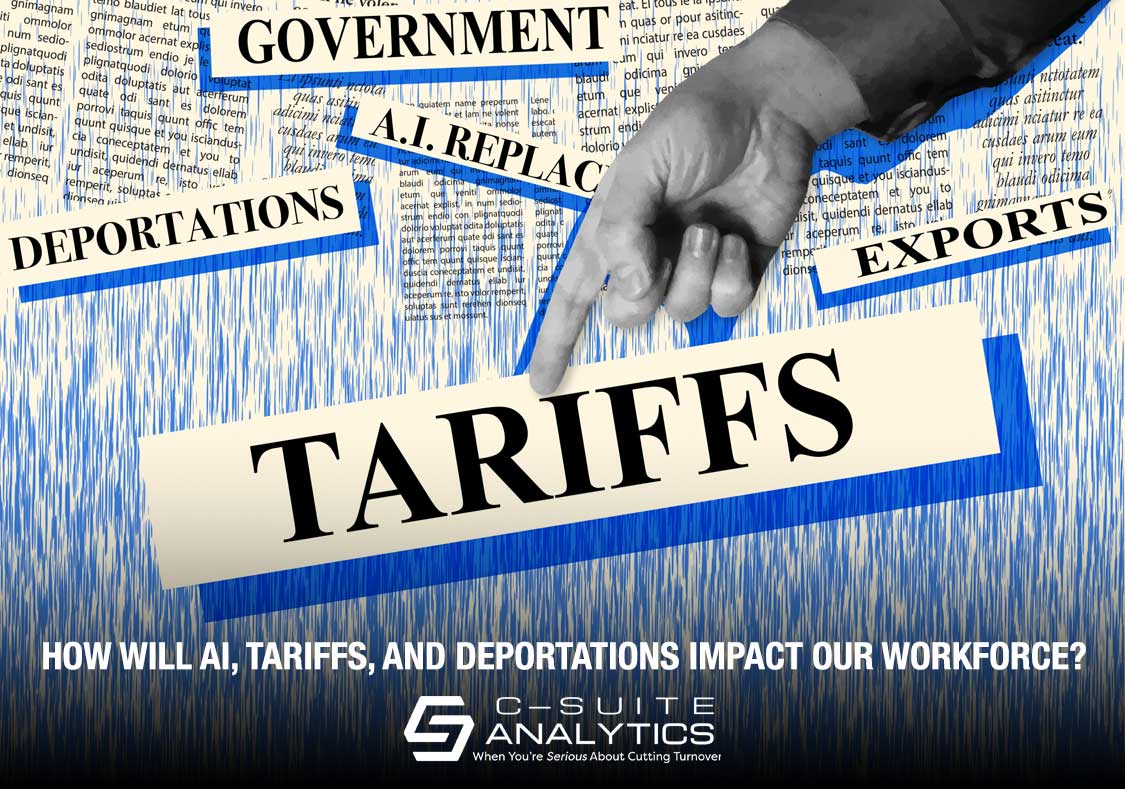AI, deportations, tariffs, and birthrate declines are reshaping America's workforce—blue- and white-collar alike. From baby boomer exits to AI disruptions, breaking down the workforce challenges no leader can afford to ignore.
Americans Quit & Canadians Stay: Could It Be the Hedonic Treadmill?

Let’s be direct. U.S workers are quitters. And a recent experience put that into full perspective when a client company executive said, “Let’s just work on cutting turnover in the U.S. Our Canadian plants always have low turnover”. Other executives have said similar things over the years so this time I looked it up.
Let’s call Canadians our closest first cousins. They are capitalists just as we are, they manage nearly identical industries, our sports teams cross the border to play each other. Maybe they are more tame politically but that’s about the only first-glance, obvious difference. So as we compare data, let’s look first at the U.S.:

Based on our U.S. Bureau of Labor Statistics, this chart depicts the percent of U.S. workers who voluntarily quit their jobs. Reading left the right, the data discloses that jobs increased as we came out of the great recession and so did quits, up to an all-time high in 2019 of 28%. Quits decreased during the pandemic year of 2020 but just by 14% from 2019’s total. In fact, by the 4th quarter quits were down less than 10%. You can imagine employees wearing masks with “I quit!” stitched across the front. The pandemic wasn’t stopping U.S. workers from quitting jobs and getting new ones.
Looking then at 2021, the BLS tells us in the first quarter of this year we are on track to surpass our all-time high of 2019. Keep in mind that very few of our employees were vaccinated in the first quarter of this year…but they kept on quitting. And there is every reason to think many more will quit for better jobs as our economy ramps up and unemployment plunges to 3.2% as is predicted by year end.
The insert also discloses the incredible case of “quit-itis” that gets passed on to our young workers.
Now let’s give our Canadian cousins a fair chance to compete. Canada’s official monthly workforce report is titled “Statistics Canada”…or in French “Statistiques Canada”. The most recent report is for March of this year and I’ve studied all 27 pages. How many Canadians quit their jobs in March? The Canadian government doesn’t tell you. You can look here for yourself:
https://www150.statcan.gc.ca/n1/daily-quotidien/210409/dq210409a-eng.htm
There is plenty of information about who is working and who is not, about the percent who are unemployed and more. I might have guessed the Canadian government overlooked this statistic and that it is about the same as in the U.S…except our client executives keep echoing that Canadians just don’t quit, so maybe that’s why Canadians don’t measure quits or anything related to turnover.
So the question becomes are Canadians more attached to their jobs…or are Americans just big quitters? If employee engagement brings a clue, Gallup measures engagement for the U.S. and Canada combined, so all we know is our two countries have the highest engagement in the world, even though only about one-third of our employees are engaged.
Now for another clue worth chasing. Have you ever heard of the “Canadian dream”? Neither have I…and I mean no disrespect to Canadians. I have heard of the “American dream”, though. Google that term and you’ll find words like social mobility, freedom, opportunity, equality, do better than your parents…ideas like that. Some writers pull terms from our Declaration of Independence to verify that the “American dream” is uniquely American.
A more relevant term for the high number of Americans who quit their jobs, though, might be hedonic treadmill. And it’s a far less flattering term.
Invented by faculty who teach positive psychology, hedonic treadmill is when we strive for something and then we get it, and ultimately, we find getting it didn’t make us happier than we were before. The hedonic treadmill might relate to a different job, new relationship, new car, a new and different anything. It’s when we find that no matter what we change outside of ourselves, we are still our same selves…and our degree of life happiness is embedded in other life factors than in this example a different job.
The real culprits that block our happiness are our own rising aspirations and social comparison,[i] key word being rising. We get a raise and promotion, think we’ll be happier, and ultimately have a new peer group we want to surpass. These are the people who are described by others as “He can never be happy”. Google “Facebook jealousy” and you’ll find studies about Facebook users posting the best parts of their lives, causing others to wonder why their lives aren’t as good.
We call the U.S. the “land of opportunity”. Based on what is reported here, our charge to retain our best workers in this suddenly fast-growing economy is Herculian…and I invite you to contact me to talk through your organization’s unique challenges for which I’ll be glad to share a tip or two.
Dick Finnegan is CEO of C-Suite Analytics which consistently helps organizations cut turnover by 30% and more…and he is SHRM’s top-selling author and top-rated webcast presenter. Please email him your comments to DFinnegan@C-SuiteAnalytics.com. You are also welcome to forward this blog to anyone you believe would find it helpful.
[i] The How of Happiness, Sonja Lyubomirsky, page 50



